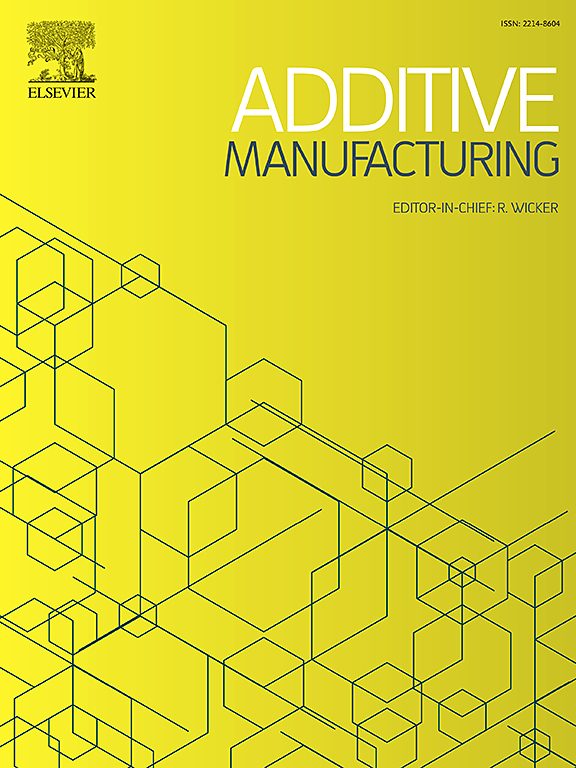Inducing inter-filament fusion during embedded 3D printing of silicones
IF 11.1
1区 工程技术
Q1 ENGINEERING, MANUFACTURING
引用次数: 0
Abstract
Embedded 3D printing (EMB3D) is an additive manufacturing technique that enables fabrication of soft materials including silicones and biological tissues. In EMB3D, a nozzle is embedded in a viscoelastic support bath and writes continuous filaments. Because the bath takes care of form holding, inks that are not printable using conventional extrusion methods can be printed using EMB3D. However, EMB3D can experience defects including positioning errors, poor inter-filament fusion, shrinkage, and rupture. Here, we use in-situ imaging experiments to investigate how defects evolve while disturbing pairs of filaments and writing triplets of filaments. By comparing written triplets to disturbed pairs, we isolate whether defects come from writing of subsequent filaments or from nozzle movement alone. Using silicone-based inks printed into water-based supports with varying concentrations of rheological modifier and surfactant, we probe how the balance between interfacial tension and viscous dissipation governs both inter-filament fusion and capillary instabilities. Critically, higher interfacial tensions and lower support viscosities lead to more rupture, more shrinkage, and more inter-filament fusion. Running the nozzle next to unfused pairs of filaments can cause fusion, but it can also cause rupture. The microstructure of the ink can also influence defects, as phase separation can inhibit both inter-filament fusion and rupture. In addition to material properties, the toolpath also controls defect formation. Fusion quality varies depending on whether filaments are horizontal or vertical in the bath, and whether filaments are stacked on top of each other or next to each other. Moreover, considerable overlap is necessary to achieve inter-filament fusion, leading to over-extrusion. Toolpaths should consider the positioning defects that come from this over-extrusion, particularly vertical displacement of horizontal lines. This work provides key guidelines to achieve prints with better shape fidelity, better resolution, and improved mechanical properties.

硅树脂嵌入式3D打印过程中诱导丝间融合
嵌入式3D打印(EMB3D)是一种增材制造技术,可以制造包括有机硅和生物组织在内的软材料。在EMB3D中,喷嘴嵌入粘弹性支撑槽中并写入连续细丝。由于该镀液可以保持成型,因此使用传统挤压方法无法打印的油墨可以使用EMB3D打印。然而,EMB3D会出现定位错误、丝间融合不良、收缩和断裂等缺陷。在这里,我们使用原位成像实验来研究在干扰对细丝和写入三联体细丝时缺陷是如何演变的。通过将写入的三联体与扰动对进行比较,我们分离出缺陷是来自后续细丝的写入还是仅来自喷嘴的运动。我们使用不同浓度的流变改性剂和表面活性剂将硅基油墨印刷到水基支架上,研究界面张力和粘性耗散之间的平衡如何影响丝间融合和毛细不稳定性。关键是,较高的界面张力和较低的支撑粘度会导致更多的断裂、收缩和丝间融合。在未熔断的细丝对旁边运行喷嘴可能导致熔断,但也可能导致破裂。油墨的微观结构也会影响缺陷,因为相分离可以抑制丝间融合和断裂。除了材料特性之外,刀具路径还控制缺陷的形成。熔丝的质量取决于熔丝在熔槽中是水平的还是垂直的,以及熔丝是堆叠在一起还是彼此相邻。此外,为了实现丝间融合,需要相当大的重叠,从而导致过度挤压。刀具路径应该考虑由这种过度挤压引起的定位缺陷,特别是水平线的垂直位移。这项工作为实现更好的形状保真度,更好的分辨率和改进的机械性能的打印提供了关键指导。
本文章由计算机程序翻译,如有差异,请以英文原文为准。
求助全文
约1分钟内获得全文
求助全文
来源期刊

Additive manufacturing
Materials Science-General Materials Science
CiteScore
19.80
自引率
12.70%
发文量
648
审稿时长
35 days
期刊介绍:
Additive Manufacturing stands as a peer-reviewed journal dedicated to delivering high-quality research papers and reviews in the field of additive manufacturing, serving both academia and industry leaders. The journal's objective is to recognize the innovative essence of additive manufacturing and its diverse applications, providing a comprehensive overview of current developments and future prospects.
The transformative potential of additive manufacturing technologies in product design and manufacturing is poised to disrupt traditional approaches. In response to this paradigm shift, a distinctive and comprehensive publication outlet was essential. Additive Manufacturing fulfills this need, offering a platform for engineers, materials scientists, and practitioners across academia and various industries to document and share innovations in these evolving technologies.
 求助内容:
求助内容: 应助结果提醒方式:
应助结果提醒方式:


